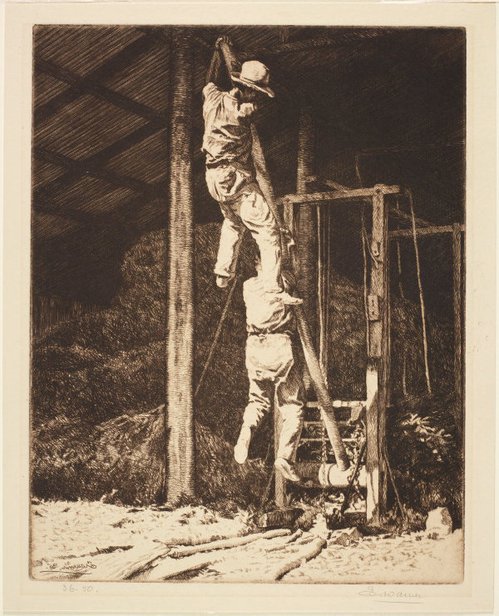-
Details
- Date
- 1935
- Media category
- Materials used
- etching printed in black ink from one plate on cream wove paper
- Edition
- 22/50
- Dimensions
- 18.5 x 23.5 cm platemark; 27.8 x 40.6 x 2.0 cm frame
- Signature & date
Signed and dated l.l., printed within plate “E. Warner ’35". [in reverse and underlined]
Signed l.r. below platemark, pencil “E Warner". [underlined]- Credit
- Bequest of Charles Warner 2020
- Location
- Not on display
- Accession number
- 156.2020.3
- Copyright
- © Estate of E Warner
- Artist information
-
E Warner
Works in the collection
- Share
-
-
About
Born in London, Edward Warner studied printing and ran a commercial art studio before travelling to Australia in 1911, then to Auckland, New Zealand where he made his first etchings whilst working as printer on The Star newspaper, he returned to Australia around 1919. As a member of the Australian Painter-Etchers' Society, Warner was a significant figure in the Australian etching revival of the 1920s and 30s. These decades saw a sustained period of creativity, energy and activity in Australian art when artists’ prints began to invite serious engagement by artists and critics for the first time, attaining a new status among artists, critics, dealers and the collecting public.
These etchings are from Warner’s remarkable series ‘Australia at work’, drawn from the artist’s travels through New South Wales, Victoria and Queensland in the mid-1930s. The series is notable for its ambition of scope, innovation of theme and precision of draughtsmanship. In this series Warner sought to celebrate manual labour throughout regional Australia rather than the more conventional subject of picturesque landscape. Notably, the series was made during the Great Depression. With much of the national economy based on agricultural production, many Australians identified prosperity with the land. Warner’s images emphasise the dignity and importance of rural labour, and its role in Australian self-identification. This was particularly welcome at a time when unemployment reached a peak of 32 percent in 1932 and hundreds of thousands of Australians were out of work.
Warner’s etchings were often printed from a clean-wiped plate to produce a sharp contrast between the crisp black etched line and the white of the paper, lending the work a sun-bleached, almost photographic quality, indicative of brilliant Australian sunlight.
-
Bibliography
Referenced in 1 publication
-
Josef Lebovic Gallery, Edward Warner (1879-1968), Australian printmaker, Paddington, 2009, p. 10 cat. 48 (colour illus.).
-




